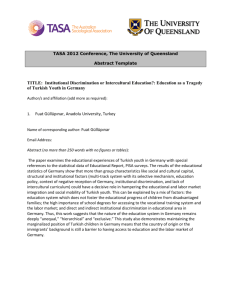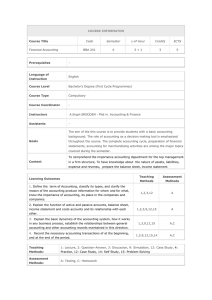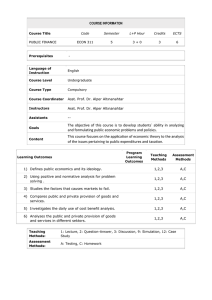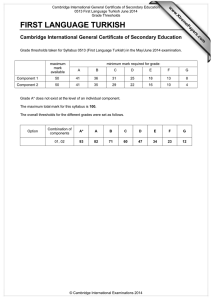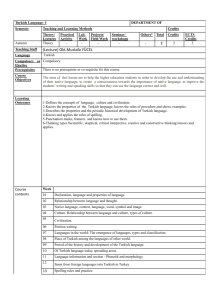2011 VCE Turkish written examination Assessment Report
advertisement
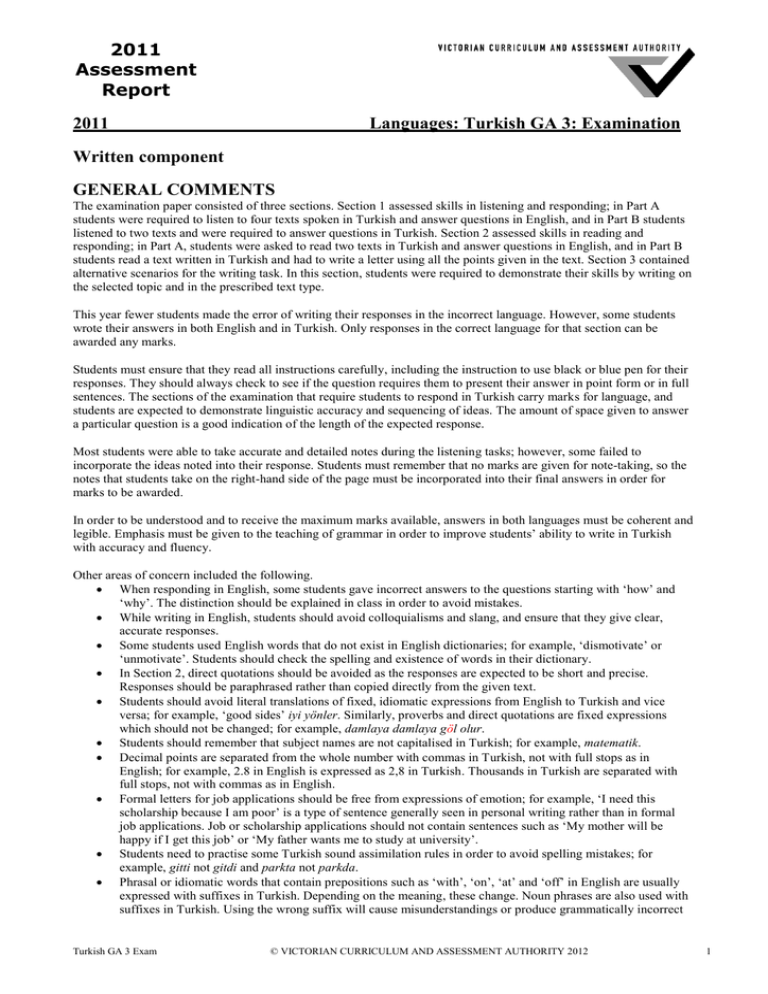
2011 Assessment Report 2011 Languages: Turkish GA 3: Examination Written component GENERAL COMMENTS The examination paper consisted of three sections. Section 1 assessed skills in listening and responding; in Part A students were required to listen to four texts spoken in Turkish and answer questions in English, and in Part B students listened to two texts and were required to answer questions in Turkish. Section 2 assessed skills in reading and responding; in Part A, students were asked to read two texts in Turkish and answer questions in English, and in Part B students read a text written in Turkish and had to write a letter using all the points given in the text. Section 3 contained alternative scenarios for the writing task. In this section, students were required to demonstrate their skills by writing on the selected topic and in the prescribed text type. This year fewer students made the error of writing their responses in the incorrect language. However, some students wrote their answers in both English and in Turkish. Only responses in the correct language for that section can be awarded any marks. Students must ensure that they read all instructions carefully, including the instruction to use black or blue pen for their responses. They should always check to see if the question requires them to present their answer in point form or in full sentences. The sections of the examination that require students to respond in Turkish carry marks for language, and students are expected to demonstrate linguistic accuracy and sequencing of ideas. The amount of space given to answer a particular question is a good indication of the length of the expected response. Most students were able to take accurate and detailed notes during the listening tasks; however, some failed to incorporate the ideas noted into their response. Students must remember that no marks are given for note-taking, so the notes that students take on the right-hand side of the page must be incorporated into their final answers in order for marks to be awarded. In order to be understood and to receive the maximum marks available, answers in both languages must be coherent and legible. Emphasis must be given to the teaching of grammar in order to improve students’ ability to write in Turkish with accuracy and fluency. Other areas of concern included the following. When responding in English, some students gave incorrect answers to the questions starting with ‘how’ and ‘why’. The distinction should be explained in class in order to avoid mistakes. While writing in English, students should avoid colloquialisms and slang, and ensure that they give clear, accurate responses. Some students used English words that do not exist in English dictionaries; for example, ‘dismotivate’ or ‘unmotivate’. Students should check the spelling and existence of words in their dictionary. In Section 2, direct quotations should be avoided as the responses are expected to be short and precise. Responses should be paraphrased rather than copied directly from the given text. Students should avoid literal translations of fixed, idiomatic expressions from English to Turkish and vice versa; for example, ‘good sides’ iyi yönler. Similarly, proverbs and direct quotations are fixed expressions which should not be changed; for example, damlaya damlaya göl olur. Students should remember that subject names are not capitalised in Turkish; for example, matematik. Decimal points are separated from the whole number with commas in Turkish, not with full stops as in English; for example, 2.8 in English is expressed as 2,8 in Turkish. Thousands in Turkish are separated with full stops, not with commas as in English. Formal letters for job applications should be free from expressions of emotion; for example, ‘I need this scholarship because I am poor’ is a type of sentence generally seen in personal writing rather than in formal job applications. Job or scholarship applications should not contain sentences such as ‘My mother will be happy if I get this job’ or ‘My father wants me to study at university’. Students need to practise some Turkish sound assimilation rules in order to avoid spelling mistakes; for example, gitti not gitdi and parkta not parkda. Phrasal or idiomatic words that contain prepositions such as ‘with’, ‘on’, ‘at’ and ‘off’ in English are usually expressed with suffixes in Turkish. Depending on the meaning, these change. Noun phrases are also used with suffixes in Turkish. Using the wrong suffix will cause misunderstandings or produce grammatically incorrect Turkish GA 3 Exam © VICTORIAN CURRICULUM AND ASSESSMENT AUTHORITY 2012 1 2011 Assessment Report sentences. For example, Senden gurur duyuyorum (I am proud of you) should be written as Seninle gurur duyuyorum. Structures and rules for forming noun phrases as well as adjectival and verbal phrases vary from one language to another. Verb endings that indicate person and number should agree with the subject of the sentence. Repetition of words, sentences and paragraphs should be avoided. While writing in Turkish, anglicisms should be avoided if a Turkish equivalent exists. ki, which is a noun phrase marker, and de and da, when used to mean ‘in addition’ or ‘also’, are separate words rather than suffixes in these cases. SPECIFIC INFORMATION Section 1 – Listening and Responding Part A – Answer in English Students responded well to most questions in this section of the examination. They were generally able to extract the main points required and could find reasonable English equivalents for their answers. Some students competently answered questions without taking notes, while some others took elaborate notes but failed to use the information in their responses. Students should practise their listening comprehension skills by selecting key points from a variety of spoken texts during their examination preparation. In the examination reading time, students should read the questions carefully to predict the type of interactions they will be hearing and the sort of information that may be required. They should take notes during the first and second playings of each text, and in the pause between playings they should read the questions again to determine the importance of what they have heard and use their dictionary to check the meanings of unfamiliar words. After the second reading of the text, students have time to confirm their earlier information and compose an appropriate answer for each question. Students should use their examination time wisely, remembering that they are being asked to demonstrate ‘the capacity to understand general and specific aspects of texts by identifying and analysing information and convey the information accurately and appropriately’. Text 1 Question 1 (C) There is heavy air traffic at the airport. Text 2 Question 2a. The student wants to do two weeks of work experience. Question 2b. The student knows that the workplace uses a variety of computer programs. She searched the internet to get the information. Question 2c. She cannot work with: those who put on/apply excessive pressure those who make demoralising/negative criticisms. Text 3 Question 3a. (To all fishermen): Not to sail too far away from the coast. (To fishermen who do surf fishing): To be careful and on the alert for freak/sudden waves. Question 3b. Sea Big waves (high seas) Coast Mountains Blanketed with fog until noon Very cold (below freezing) Question 3c. They should prepare well. Turkish GA 3 Exam Published: 3 July 2012 2 2011 Assessment Report Text 4 Question 4a. Taner uses a warm/sincere phrase when he leaves his message/Taner calls her Hulya’cığım (my dearest Hulya). Hulya is a relative/his wife’s sister/his sister-in-law. Question 4b. Because he knows that Hulya is also sensitive/concerned about the environment. Question 4c. Issues There is a litter problem at the beach. The rubbish is affecting the sea creatures (when mixed with salt water). There is a proposal to install rubbish bins. Suggestions Establish a group of volunteers (to clean up the beach). Stand against the proposal for installing rubbish bins (because they are too costly and detrimental to the environment). Suggest that people should take their rubbish home with them (after leaving the beach). Part B – Answer in Turkish The majority of students were able to answer the questions asked in this section with some clarity, but not in as much detail as expected from students at this level. Some responses were written in basic language, lacking structural accuracy and fluency. Students should be prepared to give responses that are structured appropriately according to the question asked. If the question asks for the information to be presented in point form or a list, students should respond in this way. Where a question requires an additional explanation, the response should be constructed in the appropriate manner rather than just giving the key words as an answer. Students should also give precise responses. Text 5 Question 5a. The competition was held to celebrate the fact that Istanbul had been selected as the ‘Cultural Capital’ of the world. Question 5b. The materials: made house construction easier enabled energy savings. Question 5c. Bilimsel Araştırma Kurumuna: for their financial support Eşine: for being with him during the project Hilmi Korkmaz’a: for selecting/editing and producing the film Text 6 Question 6a. In a multicultural society you can: learn about other cultures promote your own culture. Question 6b. The guest says that: his culture is not being promoted enough/sufficiently there are not enough folk dancing groups waiters/waitresses in restaurants do not wear traditional costumes (he thinks they should dress up traditional) there are no suitable places where young people can listen to Turkish music. Turkish GA 3 Exam Published: 3 July 2012 3 2011 Assessment Report It appeared that fewer students than in previous years had difficulty analysing the spoken texts using intonation, stress and the structure of the conversations. Students should be taught the skills needed to analyse and understand the deeper meaning hidden in spoken texts. Section 2 – Reading and Responding Part A – Answer in English This section of the examination assessed students’ capacity to understand and convey general and specific aspects of a written text. Part A of Section 2 consisted of two separate texts, with questions worth 20 marks. Responses were required to be in English. Most students were able to draw the appropriate information from the text. Students were also required to analyse the stylistic features of the text. The spaces provided for the responses generally indicated the length of the anticipated answer. Students were asked for a global understanding of the text and although many managed well and demonstrated a sophisticated understanding of text construction and the purpose of this text in particular, some students simply attempted to translate statements directly from the text. In order to prepare for this section of the examination students should read extensively in Turkish, including a wide range of texts in different text types. They should also practise identifying, rephrasing and summarising the main points and ideas in texts. Before attempting the questions in this section, students should read the text a few times and use their dictionaries to clarify the meaning of unfamiliar words. However, it is not necessary to know the meaning of all words; students should try to understand the gist of the passage and find the information required to answer the questions. Students are also reminded that all answers must be based on the information provided in the text. Text 7 Question 7a. Either of: because the bridge joins Asia and Europe because the event was moving from Asia to Europe. Question 7b. 134 countries and territories were involved at an international level. At a national level in Turkey, 250 businesses and tens of thousands of people were involved in the event (plus 2000 online supporters). Question 7c. In his speech, Tolga Bastak emphasises that we are using resources at a rapid rate. He does this by explaining that we will need the resources provided by two planets by 2030 and the resources provided by 2.8 planets by 2050. Of course, we only have one planet, so he is showing us that we cannot keep using resources at the rate we are using them now. Question 7d. Tolga Bastak is optimistic about the effectiveness of the event because he believes that: making small changes in our lifestyles is worthwhile making even small changes (such as switching off the lights for one hour) will make us use our resources better making small changes (such as switching off the lights for one hour) will reduce the pressure on our planet if people work together (this is symbolised by everyone switching off the lights together for one hour) then a healthy planet will be the result. Text 8 Question 8a. Because the restaurant: has very good food (particularly seafood) has views of the sea is modern, authentic, comfortable, culturally appropriate and has a welcoming decor has a balcony for outdoor dining Turkish GA 3 Exam Published: 3 July 2012 4 2011 Assessment Report has authentic food has friendly staff is affordable. Students were required to give any four of the above responses. Question 8b. Either of: a weekday/any day during the week, because there are special fish dishes on the menu (on weekdays) on a Saturday, because there is a buffet which is only available on Saturdays. Question 8c. The reviewer wants to cook the recipe she likes (she has the recipe), but she cannot cook it well, so she goes back to the restaurant again and again hoping to identify a secret ingredient (the ingredient that she thinks might be missing from the recipe). Question 8d. The review is very effective for its purpose and audience because (any two of): she uses a range of positive and colourful words to describe the food and the place so that the readers/audience will be able to imagine the restaurant she paints a detailed, welcoming picture of the restaurant’s environment for the readers/audience she raises the curiosity of the readers by talking about a secret and encourages the readers/audience to help her identify this secret (this will make the readers of the review want to come to the restaurant). Part B – Answer in Turkish This part of the examination assessed students’ capacity to understand general and specific aspects of the text and their capacity to convey information accurately and appropriately in Turkish. The task required students to demonstrate their skills by writing a formal letter in a persuasive style using only the information provided in the text. Students need to practise writing in different text types to prepare for this part of the examination and should refer to the VCE Turkish Study Design for the identified conventions in these text types. Students are assessed using the following criteria: understanding general and specific aspects of a text by identifying, analysing, and responding to information conveying information coherently (structure, sequence, accuracy and variety of vocabulary and sentence structure) and appropriately (relevance, use of conventions of the text type). Most students produced work that conveyed all the necessary information and many did it in a variety of grammatically correct and interesting ways. The more capable students manipulated language authentically and creatively and organised information and ideas well in Turkish in order to meet the requirements of the task. Some students used only a few of the ideas provided in the text and attempted to complete the task basing it on their personal knowledge and experience. Section 3 – Writing in Turkish Students were required to write 200–250 words in Turkish in response to one of the questions. Each question represented a different text type and kind of writing. It should be noted that the text types marked with an asterisk on page 13 of the VCE Turkish Study Design are those which students may be expected to produce in the examination. This section assessed the students’ ability to express ideas through the creation of an original text in Turkish using the following criteria: relevance and depth of treatment of ideas, information or opinions accuracy and range of vocabulary and sentence structures the capacity to structure and sequence response and capacity to use conventions of the text type. The majority of students chose to write in the more popular and familiar text type, the personal letter (Question 10). Questions 12 and 13 were also attempted by a significant number of students who produced creative pieces of authentic writing. The least popular, Question 11, was an imaginative task. Turkish GA 3 Exam Published: 3 July 2012 5 2011 Assessment Report Most students displayed a good knowledge of the text types and styles of writing they chose. However, many responses demonstrated a lack of depth in the treatment of the task, often because students did not read the questions thoroughly and because they had a limited range of vocabulary. The selected topic should be one for which students have a good range of vocabulary and one in which they are able to express themselves in Turkish with fluency and accuracy. Some students demonstrated their planning skills by writing basic notes prior to embarking on the actual writing task. Ideas should be developed coherently and grouped into separate paragraphs with effective links between and within them. It is therefore essential that students set aside time to plan their response and time to proofread it at the end. Students should be familiar with the assessment criteria used in this section of the examination (see above) and structure their writing accordingly. Turkish GA 3 Exam Published: 3 July 2012 6
